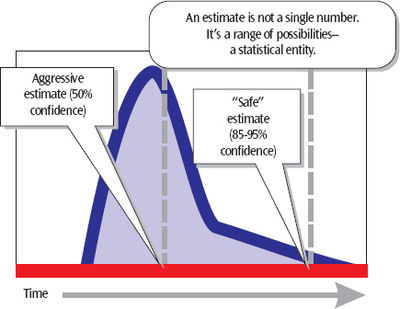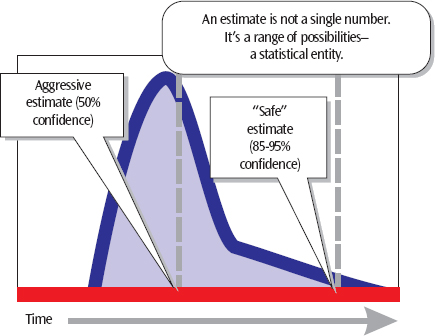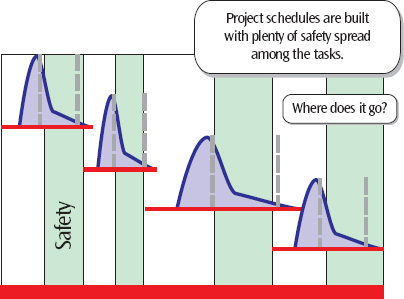Critical Chain
(→Time management in projects) |
(→Time management in projects) |
||
| Line 8: | Line 8: | ||
===Time management in projects=== | ===Time management in projects=== | ||
Often rough estimates are made to produce a seemingly complete project schedule with task due dates and important milestones. Since there is high uncertainty in this planning stage in accordance with the rolling wave principle, a high safety margin is placed between project deliverables to reduce the risk of project delays. Other reasons for a high safety margin can be explained by project managers protecting their estimations from a potential cut by the board or steering group meaning they will state double the safety they actually need. In general time estimates are based on a pessimistic experience and often the larger the number of management involved, the higher the total safety estimation will be. Each level in the organization will simply add their own safety factor on top of the others. | Often rough estimates are made to produce a seemingly complete project schedule with task due dates and important milestones. Since there is high uncertainty in this planning stage in accordance with the rolling wave principle, a high safety margin is placed between project deliverables to reduce the risk of project delays. Other reasons for a high safety margin can be explained by project managers protecting their estimations from a potential cut by the board or steering group meaning they will state double the safety they actually need. In general time estimates are based on a pessimistic experience and often the larger the number of management involved, the higher the total safety estimation will be. Each level in the organization will simply add their own safety factor on top of the others. | ||
| − | |||
| − | |||
| − | |||
Two problems often arises in relation to being on time in projects. | Two problems often arises in relation to being on time in projects. | ||
| Line 17: | Line 14: | ||
Critical Chain acknowledges the need of safety margins in projects to reduce risks but safety margins will not prevent the project from being late due to the aforementioned problems. Furthermore, these safety margins are shared globally by the whole project meaning that the performance of the project in terms of time management is evaluated globally. | Critical Chain acknowledges the need of safety margins in projects to reduce risks but safety margins will not prevent the project from being late due to the aforementioned problems. Furthermore, these safety margins are shared globally by the whole project meaning that the performance of the project in terms of time management is evaluated globally. | ||
| + | |||
| + | [[File:Safetybuffer1.jpg|400px|thumb|right|Figure 1: ''Safety buffer'' <ref name=raz> Raz, T., Barnes, R., & Dvir, D. (2001). ‘’A Critical Look at Critical Chain Project Management.'' Article in IEEE Engineering Management Review (2004) </ref>.]] | ||
| + | |||
| + | <div><ul> | ||
| + | <li style="display: inline-block;"> [[Image:safetybuffer1.jpg|550px|thumb|right|Figure 8A: ''Project Schedule without resources''<ref name=gray> Gray, C. F., & Larson, E. W. (2011). ''Project Management, The Managerial Process.'' McGraw-Hill/Irwin, NY</ref>.]] </li> | ||
| + | <li style="display: inline-block;"> [[Image:safetybuffer2.jpg|550px|thumb|right|Figure 8B: ''Gantt chart without resources''<ref name=gray> Gray, C. F., & Larson, E. W. (2011). ''Project Management, The Managerial Process.'' McGraw-Hill/Irwin, NY</ref>.]] </li> | ||
| + | </ul></div> | ||
===Critical Path versus Critical Chain=== | ===Critical Path versus Critical Chain=== | ||
Revision as of 18:34, 19 February 2023
Category:Critical Chain. OBS have not added my references yet
Contents |
Abstract
Critical Chain Project Management(CCPM) was firstly introduced by Israeli physicist, Eliyahu M. Goldratt in his book “Critical Chain”. The development of CCPM was a response to poor time management in projects that the critical path method was not able to solve. This article will firstly explain recurring problems with resource-constrained project scheduling. To describe Critical Chain fully it will be compared to its precursor, Critical Path as well as the Theory of Constraints since CCPPM stands on the shoulders of this management philosophy. The elements that Critical Chain consists of and its application will be described and lastly the company criteria for implementation are listed and discussed as well as the method’s limitations.
Critical Chain
Time management in projects
Often rough estimates are made to produce a seemingly complete project schedule with task due dates and important milestones. Since there is high uncertainty in this planning stage in accordance with the rolling wave principle, a high safety margin is placed between project deliverables to reduce the risk of project delays. Other reasons for a high safety margin can be explained by project managers protecting their estimations from a potential cut by the board or steering group meaning they will state double the safety they actually need. In general time estimates are based on a pessimistic experience and often the larger the number of management involved, the higher the total safety estimation will be. Each level in the organization will simply add their own safety factor on top of the others.
Two problems often arises in relation to being on time in projects.
- People procrastinate and start on a task to finish the task just in time, also called "The student syndrome"
- Even if a worker finishes early they use all the time available, which can be explained by Parkinson's law. If one finishes early they will expand the scope and use more effort on the task than required.
Critical Chain acknowledges the need of safety margins in projects to reduce risks but safety margins will not prevent the project from being late due to the aforementioned problems. Furthermore, these safety margins are shared globally by the whole project meaning that the performance of the project in terms of time management is evaluated globally.

Critical Path versus Critical Chain
The critical path is the longest chain of interdependent tasks in order to calculate the end-date and monitor the progress of the project. The critical chain is also the longest chain but other than interdependent tasks it also take resources into account. Resources are by some also countes as an (implicit) interdependecy.
Critical path schedules projects on task dependencies while Critical Chain is based on resources. Critical Chain does not prohibit concurrent project work but multitasking is prohibited meaning that work on one task cannot be interrupted to start another. Multitasking fails to complete tasks fast since the resource is split between multiple tasks and also due to the fact that there is a certain amount of communication time switching from one task to another.
Critical chain is the longest chain taking into account the interdependence of tasks and resources while the critical path is the longest chain of intderdependent tasks.
Critical Chain application
In order to apply Critical Chain the following steps need to be followed.
- Determine order of tasks and critical path: Identify the tasks needed to succeed with the project as well as their sequence. Determine critical path.
- Slice the duration of the tasks: Typically the PM will decide on half/half for simplicity but other slices are possible. Put the sliced task duration as a project buffer. The official end-date that is communicated to stakeholders now corresponds to the project buffer’s end date.
- Level resources: Identify resource constraints and arrange tasks according to resource dependencies. Determine critical chain.
- Monitor: During the project monitor the use of the use-rate of the buffer. The use-rate helps anticipate the risk of the project's delay and respond in time.
The different buffers
Buffers are owned by everyone and therefore a shared responsibility meaning that everyone must complete their task as quickly as possible to reduce the consumption of the buffers. The 'crashed' deadlines ensures that all resources will try to complete their task as quickly as possible with the safety of the buffers to ensure quality and a healthy work environment.
Some people divide the buffers in four categories: project buffers, feeding buffers, resource buffers and capacity buffers. The most well-known buffers are the project buffer and the feeding buffer:
- The project buffers: Placed between the last task and the official completion date ensuring the final date is not prolonged
- The feeding buffers: Placed at the end of non-critical chains preventing delays to the critical chain
Limitations
Quality CCPM does not deal with project quality and by implementing tight deadlines there is a risk of poor quality in the deliverables.
Slice of project tasks Often, all project tasks

